Twenty years ago today marked one of the most significant day’s in Germany’s history. After 28 years of both a physical and psychological barrier separating East and West Berlin, the Wall came down. And it was all thanks to Günter Schabowski, a spokesperson for the politburo, who made the mistake of telling the press that the restrictions would go into effect immediately, when they weren’t to take place until at least the following day. This inaccurate information was broadcast, and East Berliners began storming the gates. Clean out of a lack of alternatives, the guards began allowing people to cross over the gates, and much of Berlin was caught up in one joyous celebration.
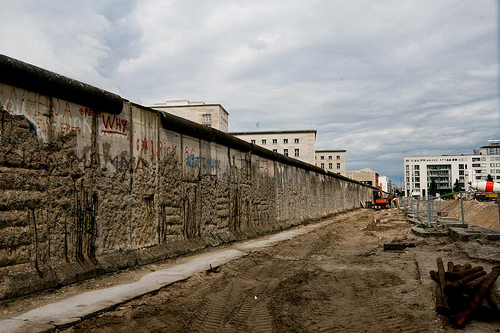
In honor of today’s anniversary, let’s take a little virtual walking tour of Berlin’s deep-rooted Cold War history, shall we?
A Look Underground
When Berlin was first divided, so was its subway system. Metal bars were drilled downward into the sewers and grates installed with the primary purpose of keeping East Berliners in. West Berliners responded by digging tunnels that offered the prisoners escape routes. In retaliation, the Stasi stationed guards underground, as well as laid nail beds by the tracks to impale attempted escapees. Entryways from these tunnels into the subway system still exist, and thousands of commuters breeze by them each day without notice, or knowing a thing about this sordid past of the underworld.
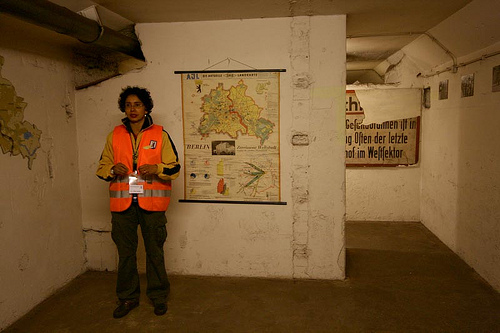
In 1997, the brick walls built atop the original underground passageways were torn down, revealing a time capsule. Responsible party, Berlin Unterwelten—an association of academics, teachers, policemen, justice officials and others interested in preserving the city’s history—assumed the task of bringing this legacy into the public eye. The non-profit group began by offering “Subways and Bunkers in the Cold War,” which was honestly one of my favorite elements of the entire trip, where visitors to Germany’s capital can retrace the footsteps through masked corridors and the multi-purpose facility built as an emergency shelter in the chance of an all-out nuclear war.
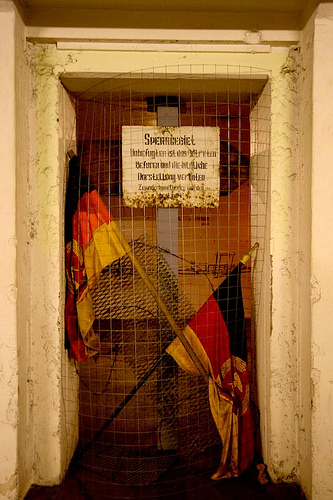
The Brandenburg Gate
What some might consider the face of the Cold War, Brandenburg Gate was constructed in the 18th century based on the ideas of Acropolis. It is the only of the city’s 18 gates to survive both wars. Many famed American presidents—Kennedy, Reagan, Clinton and, most recently, Obama—and, likewise, German chancellors, have given prominent speeches in this very plaza. From the opening of the iconic gate gazing westward is the Victory Column, or Siegessäule, erected in the 19th century to commemorate the military successes of Prussia during the Wars of Unification. In 1938, the Nazis commissioned Hitler’s favorite architect, Albert Speer, to move the column to its current location in the former Königsplatz (now Platz der Republik) as a focal point for the mounting East-West angst.
The Memorial to the Murdered Jews of Europe
Down the road, 2,711 geometric slabs hover ominously in an homage to those who died in the Holocaust. Comprising more than five acres, the Memorial to the Murdered Jews of Europe forms a forest of pillars that create an optical illusion: They appear to protrude from the earth just high enough to serve as benches, but in actuality range from eight inches tall to nearly 16 feet, fully engulfing visitors as they delve into the concrete maze. In Bebelplatz, watch where you’re stepping; otherwise, you might just pass over the memorial for the 1933 Nazi book burning and not even realize it’s there. Built well below ground by Micha Ullman in 1995, the art display—a glass-topped tomb of empty bookcases symbolizing the 20,000 pieces of work that went up in flames—is spectacularly lit and best viewed once the sun has set.
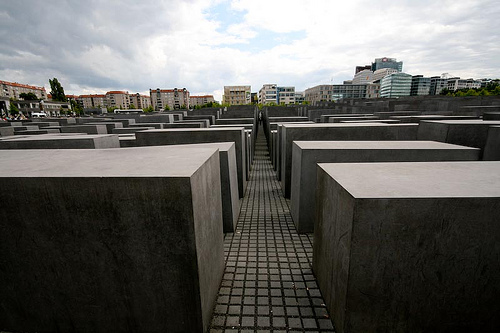
The Berlin Wall
Some Berliners have even figured out a way to monetize artifacts and a tourist’s love of tragedy; in fact, there’s a whole swath of Wall-related memorabilia around the most heavily-trafficked areas. In Potsdamer Platz, get your passport stamped with “official” souvenir symbols delineating that you’ve crossed into East Berlin. Take home photographic evidence that you met “Checkpoint Charlie”—no longer just a defining symbol of the Cold War, but an open-air exhibit complete with actors posing as allied military policemen—which has become a prime spot for photo opps (though you’ll be forced to fork over a euro for “Charlie’s” trouble). You can always purchase an “authentic piece” of the Wall to take home with you, too, or so says the persistent salesman, who can rattle of his sales pitch in half a dozen languages.
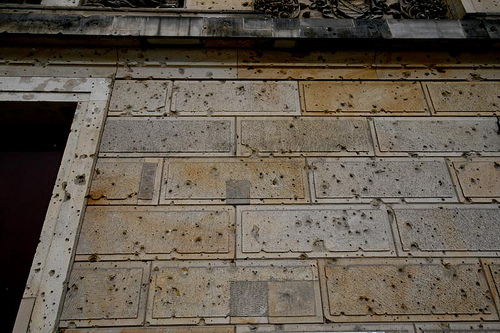
Biking Through Berlin
Still, reputable enterprises with noble intentions to educate the public, like Berlin Unterwelten, do exist. Berlin on Bike offers six interactive tours that explore various nooks of the city with a seasoned guide to advise cyclists on history. Most popular of the routes is the seven-mile Wall Tour, which pedals past remaining segments in both the East and West, train stations, and border crossings and even pays a visit to the last remaining watch tower, now guarded over by the brother of its first casualty. Likewise, educational Videobus Tours provide a more vivid glimpse of what really happened during the war through applicable newscasts and video footage streamed overhead in the bus en route to each featured point of interest.
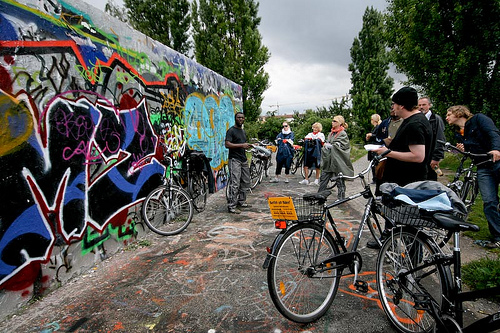
While evidence like the dilapidated segments of the Wall stand as often subtle reminders of what the city once was, visitors to Berlin as few as five years ago may no longer recognize the once war-torn land. Parts of the capital, West Berlin in particular, have been whitewashed, the cranes (mostly) replaced by modern art structures, the stricken and somber perspective superseded by hope and optimism. The city’s dirt cheap cost of living has attracted expats from all nooks and crannies, who now populate thriving neighborhoods like Prenzlauer Berg in the east, Kreuzberg in the west, bringing with them tastes and talents from all over the world and creating a melting pot effect.
Street Art in Germany
Even the symbolic Eastside Gallery, a section of the Wall named for the living art installation it bears, will get a facelift come fall. Those surviving 180 artists who originally transformed the structure in 1990 were invited back earlier this year to paint over the mile stretch of murals that have attracted thousands of visitors in their two decades standing.
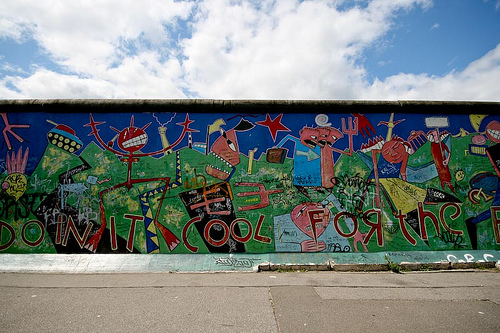
That’s not to say the art scene starts and ends with the Wall. On any day, it’s not uncommon to stumble upon unassuming exhibit openings of well-known artists, like Italian-Brit duo Gilbert & George, at spots like Halle am Ufer. Berliners have simply learned to make do with what they have—a cleared-out air bunker, for example, now houses one of the city’s most interesting modern art museums, Boros, a private collection for view by appointment only. And a whole host of contemporary galleries, many highlighting the works of international artists who have sought solace in Berlin’s affordability and camaraderie in the artistic community, have cropped up in Hackescher Markt, a famously industrial neighborhood that’s undergone a massive gentrification; around Hackesche Höfe, the former Jewish quarter; behind the old train station Hamburger Bahnhof, which is now a museum itself, and along Heidestrasse. In fact, Berlin is estimated to house 450 galleries, many of which inhabit vacated factory spaces, with a new one popping up every week or so.
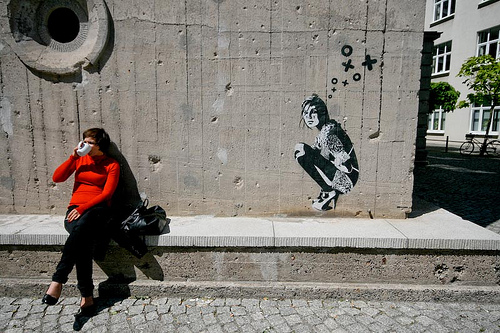
Where to Stay in Berlin
The hotels follow suit, too. Rocco Forte property Hotel de Rome, opened in 2006, is a shining example of Germany’s inclination to recycle the old to make way for the improved; its designers utilized the existing architectural splendor—a bank erected in 1889, it still inhabits the original structure—to transform the once decrepit building into the city’s poshest lodging option. Even its spa is located in the old vault (guests can pay a pretty penny to dine down there), and entrances to guest accommodations are designed to mimic this overall theme. Bauhaus decor, soaring ceilings, mosaic bathroom floors and a swank rooftop bar complete the perfectly-executed package.
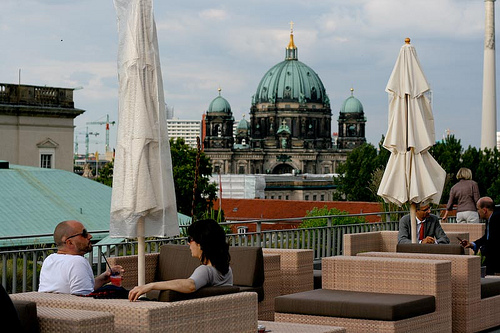
That’s just a little of what I uncovered during my whirlwind week in Berlin this summer. I won’t claim to be an expert on the Cold War or even pretend to remember the day the Wall fell—heck, I was only six at the time, after all—but this is what I experienced, a history lesson through travel, the most valuable kind. Scott told me today that many Germans don’t even recognize today as any sort of celebration, because historically a lot of bad things happened on Nov. 9. I still think it’s important to memorialize this day regardless, as history has this annoying way of repeating itself.
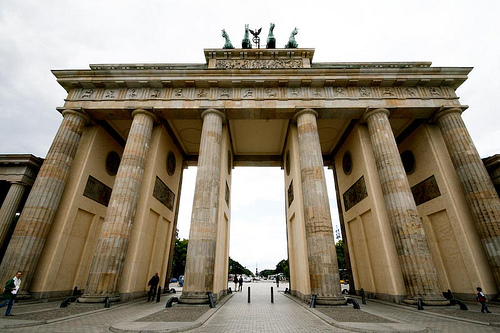
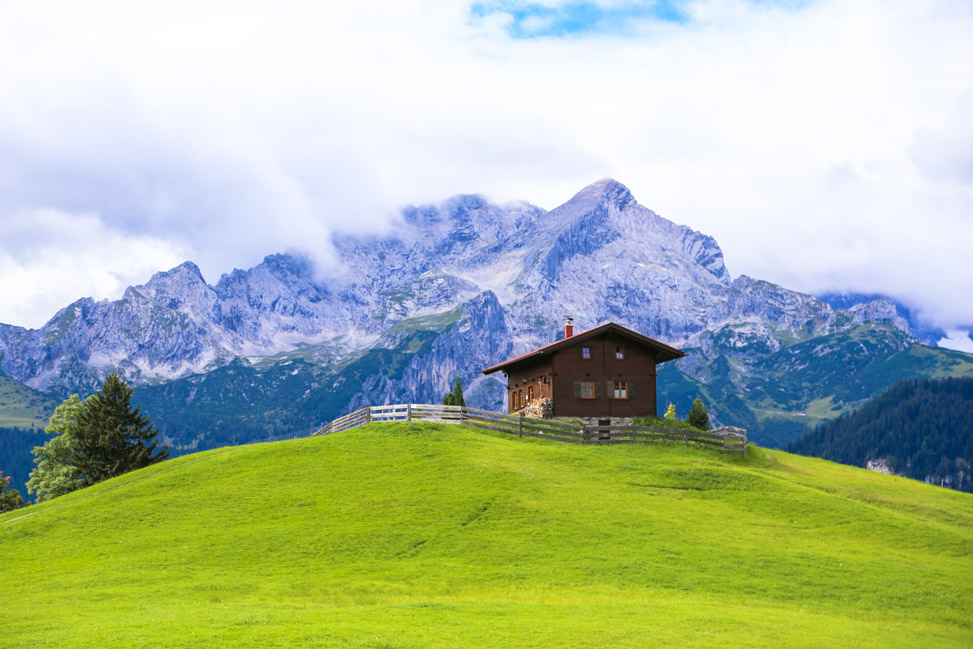
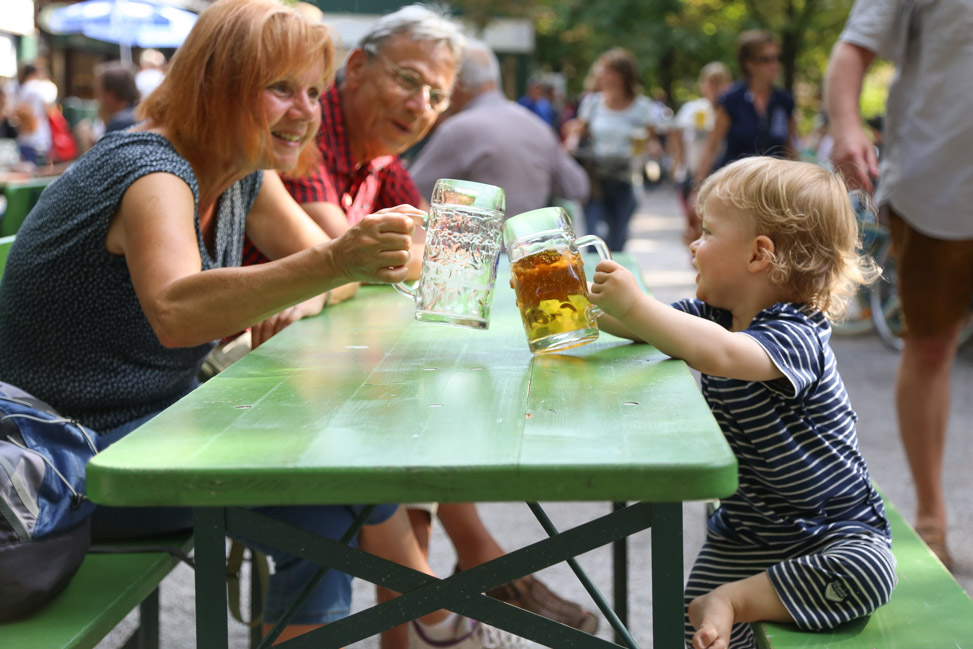
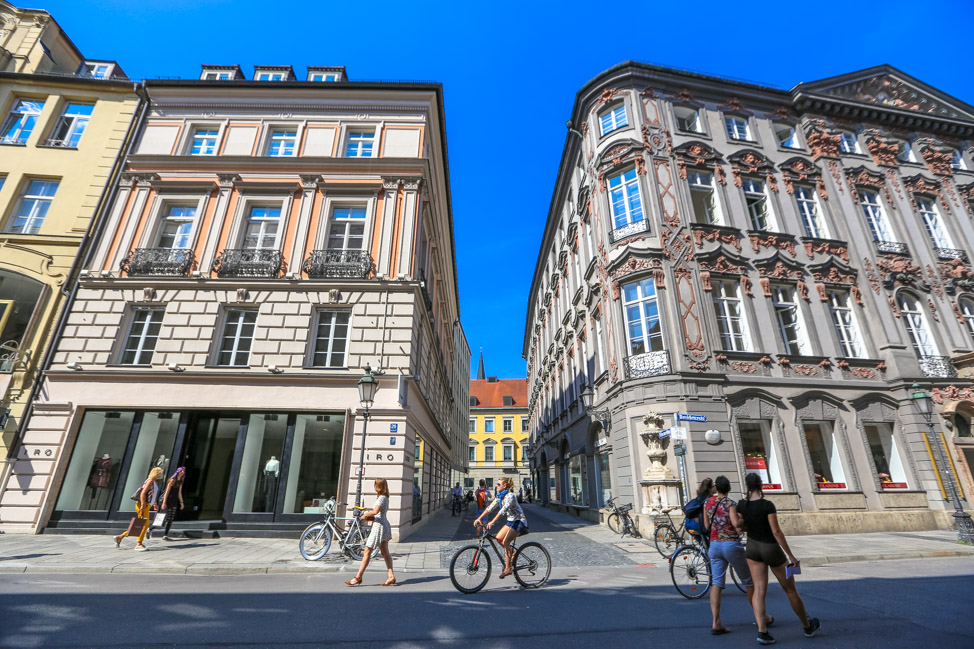
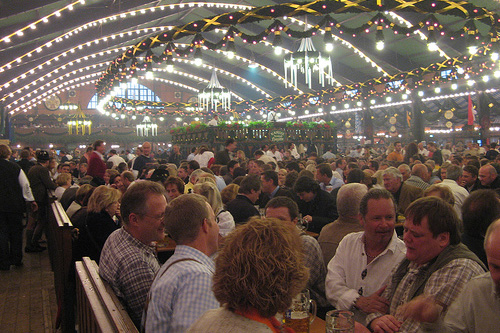

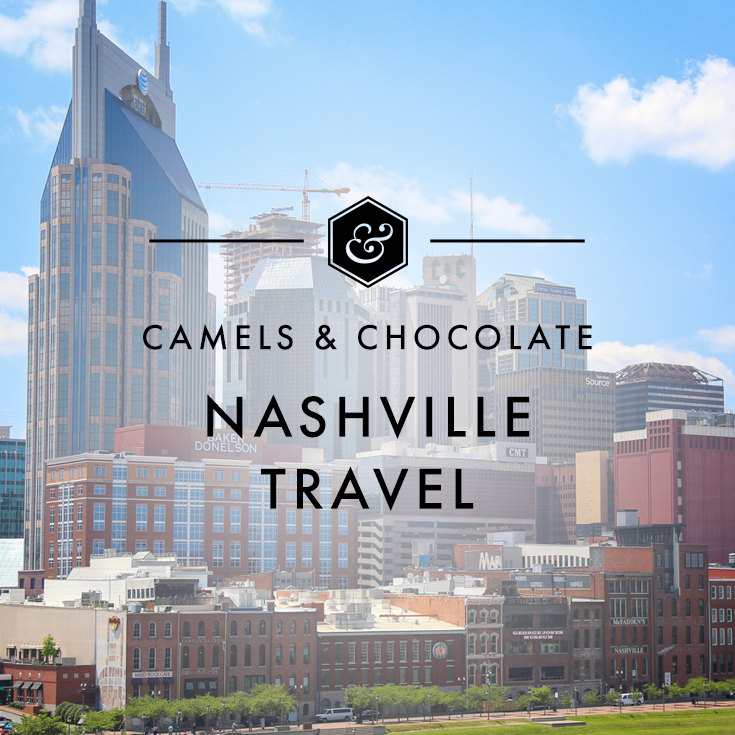








A great post and tour in memory of this significant day in history.
I feel like I just learned more today reading this post than I did doing, well, anything else. Awesome.
I agree, quite a significant day in their history(from revolts and horror, to the fall of the Berlin Wall), and it seems right that the final event which closes the chapter that was Nov 09 is a good one.
Yeah, history lessons experienced through travel is quite interesting, but I must admit that my love affair with the subject of history begins with the books themselves. I know, boring! 🙂
Interesting stuff – thanks for sharing…
Interestingly enough, my Mum went to Berlin as a child in the late 60s with her school choir from London. They were one of the few groups allowed to cross from West Berlin to East Berlin to give a concert, and she still remembers it as being one of the most terrifying experiences of her life when the coach they were travelling on was stopped and searched and every single pupil was searched in case they tried to smuggle any East Berliners out with them.
We still have a teddy bear she brought back from East Germany as a souvenir at home although he looks a bit old and battered now!
I enjoy my armchair travels with you. Great post.
This is a such a timely and great post! I agree that no matter how bad the memory of the day is we owe it to them to recognize the hardship that happened. I have learned a lot just reading your post today. Also love all the pictures in the post.
Excellent photography Ms. Kristin. Particularly LOVE the graffiti and coffee drinker. Very well timed that one.
My 62 year old boss yesterday said that people under 40 don’t remember the fall of the Berlin wall. I had to correct him. I was 10 in 1989 – old enough to remember the dramatic news footage of the celebrations, the people climbing over, the drinking, the pounding away at the concrete. I guess four years difference at that point in life makes a big difference in what we remember. Great post!
Gorgeous photos and a beautiful post. I was a freshman in college and remember watching the fall in my dorm. I’d just moved from a tiny 6,000 person town to go to college, and here I was with my new friends in my new life watching history. I felt a sea change in my world view then.
The photo of the pock-marked wall was one my favorites. That was the most striking things I recall about when I went to Berlin almost 15 years ago. The scars that still are visible on the architecture.
In slightly-related-but-not-really news, Günter Schabowski is THE BEST NAME EVER.
That said, I agree! Beautiful photography!
hey, I remember ALL of it, the wall being built, falling, etc. As a matter of fact, in 1971 I went to Berlin and was allowed to go to East Berline on a bus. While passing thru Checkpoint Charlie I got off the bus and started taking pictures of the guards inspecting the bottom of the bus for escapees. Uh-oh… so long film… I never saw those pics. The city itself was so dreary and depressing. I spent a day there… never wanted to go back.
loved berlin, but was denied entrance to a club for not being dressed correctly.